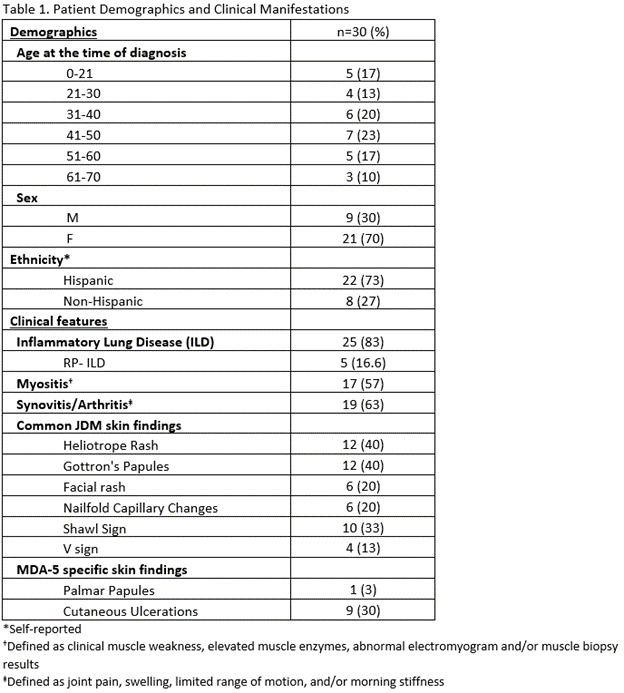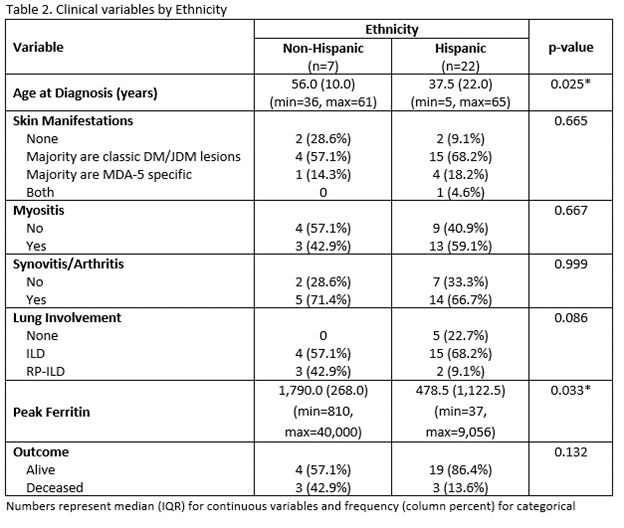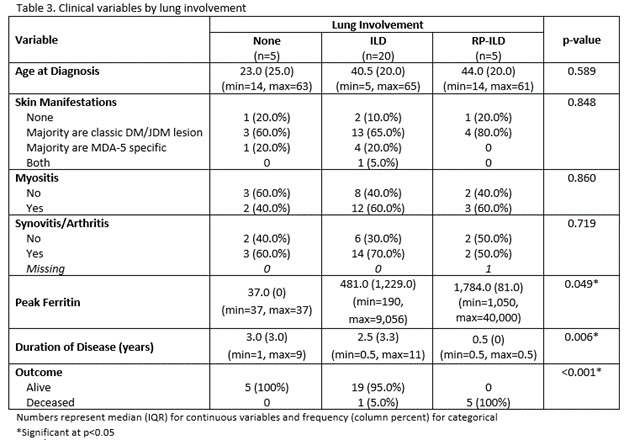Session Information
Date: Sunday, November 12, 2023
Title: (0283–0307) Muscle Biology, Myositis & Myopathies – Basic & Clinical Science Poster I
Session Type: Poster Session A
Session Time: 9:00AM-11:00AM
Background/Purpose: There is little to no data about the presentation and clinical course of anti-melanoma differentiation-associated gene-5 antibody (anti-MDA-5) dermatomyositis patients in a primarily U.S. Hispanic population. We describe the clinical presentation and outcomes of anti-MDA-5 dermatomyositis in our urban, majority Hispanic rheumatology patient population.
Methods: This is a multicenter, retrospective case series of patients with anti-MDA-5 dermatomyositis. All patients diagnosed with anti-MDA-5 dermatomyositis and encountered in the clinical setting from June 2015 to March 2023 at four academic medical centers in Los Angeles, California by rheumatologists or dermatologists were included. Demographics and clinical characteristics were obtained. Descriptive statistics were presented using frequency and percent for categorical variables and median (IQR) for continuous variables. Associations between categorical variables were assessed using Pearson’s chi-squared or Fisher’s exact test, and differences in continuous variables were evaluated using a Wilcoxon rank sum test or Kruskal-Wallis test. All tests were two-sided, and a p-value< 0.05 was considered statistically significant.
Results: A total of 30 patients with at least one positive assay for anti-MDA-5 dermatomyositis with a wide variety of clinical manifestations were included (Table 1). Nearly three-quarters of our patients (73%) were Hispanic. Twenty-one patients (70%) were female, with a median age of 40.5 years (IQR [26, 54]). Five patients were pediatric patients (< 18 years old). Hispanic patients were diagnosed with anti-MDA-5 dermatomyositis at a younger age compared to non-Hispanic patients (median age 37.5 years vs. 56.0 years; p = 0.025) (Table 2). Male patients were more frequently diagnosed with inflammatory arthritis compared to female patients (100% vs. 52.4% respectively; p = 0.027). There were 13 patients (43%) without evidence of myositis. Twenty-five patients (83.3%) had evidence of interstitial lung disease (ILD), and a higher ferritin level was associated with ILD (p = 0.049) (Table 3). There were 6 deaths in our cohort, of which 5 were ascribed to rapidly progressive ILD.
Conclusion: In our primarily Hispanic population of urban Los Angeles, anti-MDA-5 dermatomyositis has a wide spectrum of manifestations, with ILD being one of the most common clinical presentations. On average, Hispanic patients were diagnosed with anti-MDA-5 dermatomyositis at a younger age compared to the non-Hispanic patients in our cohort. Like prior studies, there was an association between higher ferritin level and the presence of ILD. While skin ulceration has been reported to be associated with lung involvement, the association was nonsignificant in our cohort, likely due to the small sample size. This is a first study looking at clinical phenotypes of a primarily Hispanic U.S. population. Larger multi-institutional studies are needed to better understand clinical phenotypes of this population in order to recognize and treat anti-MDA-5 dermatomyositis in a timely manner, especially given the high proportion of amyopathy and ILD.
To cite this abstract in AMA style:
Alhassan E, Yi B, Rodman J, Wise L. Characteristics of Anti-MDA-5 Associated Dermatomyositis in Southern California with a Large Hispanic Population: Case Series [abstract]. Arthritis Rheumatol. 2023; 75 (suppl 9). https://acrabstracts.org/abstract/characteristics-of-anti-mda-5-associated-dermatomyositis-in-southern-california-with-a-large-hispanic-population-case-series/. Accessed .« Back to ACR Convergence 2023
ACR Meeting Abstracts - https://acrabstracts.org/abstract/characteristics-of-anti-mda-5-associated-dermatomyositis-in-southern-california-with-a-large-hispanic-population-case-series/



